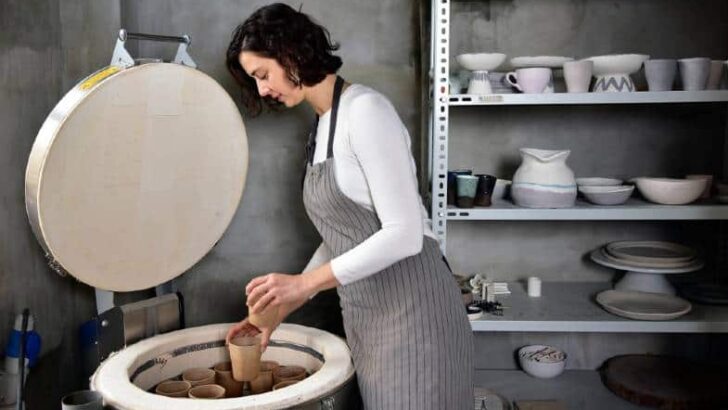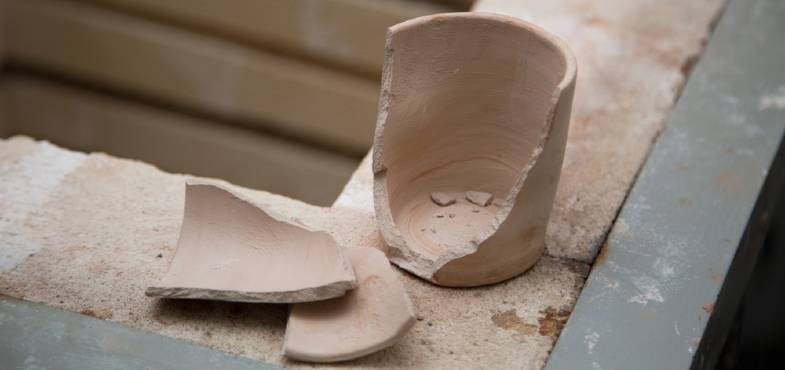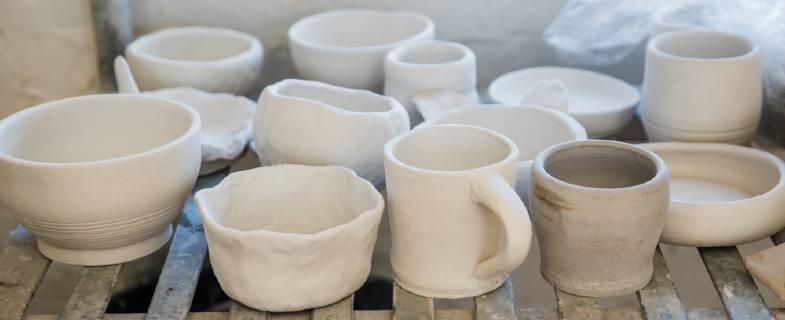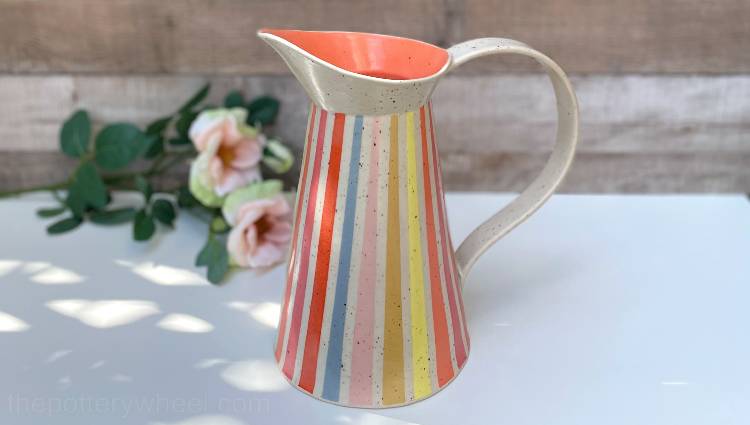Your cart is currently empty!
What is Candling a Kiln and How is it Done? – Key Facts
Published:
Last Updated:

Affiliate Disclaimer
As an affiliate, we may earn a commission from qualifying purchases. We get commissions for purchases made through links on this website from Amazon and other third parties.
One of the first things you learn about firing pottery is that it needs to be dry before it’s fired. You may have heard the quaint term ‘candling’ and wondered what it means. In this article, I look at what candling a kiln means and why is it so important.
Candling a kiln involves heating pottery for several hours below 212F. Pottery is typically candled at around 185-200F, which is just below the boiling point of water. This causes residual moisture and mechanical water in the clay to evaporate slowly. And prevents pottery from exploding when water turns to steam.
It’s important that you dry your pottery out as much as possible before it is put in the kiln. This is because if your clay contains moisture, it will turn to steam as the kiln reaches 212F.
As water turns to steam it expands sharply in volume. The steam will move into any small air bubbles in your clay and put these air pockets under pressure. This pressure is often enough to cause the pottery to crack or explode.
So, it’s important that pottery is bone dry before it goes into the kiln. However, ensuring that your pottery is dry enough is not always easy.
All greenware pottery, even if it feels dry will contain some water. When you dry clay, the moisture content will match the level of moisture in the drying atmosphere. And even if you live somewhere extremely arid, your clay will hold water. And that is where candling comes in…

What is Candling a Kiln?
Candling a kiln involves setting it so it heats up to below the boiling point of water and holds there. A hold time on a kiln is when the kiln stops increasing in temperature for a while. If you have an electric kiln you can pre-program the kiln to hold for a particular length of time.
As the kiln holds just below 212F, some of the remaining water in the greenware will evaporate. It’s important to stress the use of the word ‘some’ in this last sentence.
When clay is greenware it still contains 3 types of water. The first is the surface water that is immediately evident to the eye. This is the water that you use to make your pottery. It is the water that goes into making slip.
The second type of water is called mechanical water. This is water that sits in the gaps between the clay particles.
However, the clay also contains water that is chemically bound to the clay particles too.
When you dry clay out in your studio, the first water to evaporate is the surface water. This can leave the surface of the clay feeling dry.
However, if the clay is cool to touch, it means that it still contains mechanical water. This takes longer to evaporate and will only dry out as far as the surrounding atmosphere allows. You can’t make the clay drier than the air it is sitting in. This is where candling comes in.
How is Candling a Kiln Done?
If you have an electric kiln, you can program the first segment of the firing schedule to pre-heat. Candling a kiln is the same as pre-heating.
When you program the kiln, you set the first segment to fire to a temperature of up to 200F. Then you program it to hold at that temperature for a certain number of hours.
Some potters will program their kiln to candle overnight. They simply set it on a preheat and leave it to dry the greenware out until the morning.
During candling, the kiln does not reach high temperatures. However, leaving the kiln unattended is not something every potter wants to do. And most suppliers recommend against it. Nevertheless, overnight candling is common practice.
Other potters will set the kiln to candle for a few hours and then return to see how it’s going. One of the arguments for candling this way is that it can save time and electricity. It may not take all night to dry your pottery out. If it is candling overnight when it is already dry, this is a waste of energy and isn’t time-efficient.
How to Tell if Your Pots Are Dry
This is one way that potters will check to see if the greenware is still emitting moisture. They open up one of the peepholes on the kiln and hold a mirror above the open peep.
If condensation forms on the mirror surface, then moisture is still evaporating into the kiln chamber. This is an indication that the pottery needs to be candled for longer.
The potter will check with a mirror at regular intervals of 2 or 3 hours. Once the mirror no longer fogs up with condensation, this suggests that the pottery is dry enough to fire.
Not all potters fully trust the condensation on the mirror trick. Their concern is that a piece of pottery tucked away at the bottom of the kiln might not be dry. If this piece is small, or far from the peephole, it may not create enough moisture to mist up the mirror.
This is one of the reasons why some potters choose to candle overnight. They would rather candle for a bit longer than might be necessary to ensure that everything is fully dry.

Kiln Ventilation and Candling
Kilns come in different shapes and sizes, and potters use different ways of venting their kiln.
If you are using a downdraft vent you need to turn this off before you open a peep hole. Using a mirror above a peep hole is a common way to check if moisture is still being produced. However, if you open a peep hole when the vent is on, you will drag cold air into the kiln. This is bad for the kiln and your pottery.
Not all potters have a ventilation system installed directly onto their kiln. They may vent, by creating a cross draft, using a fan and an open window. If this is the case, then the kiln lid can be cracked open and propped an inch during candling. Like an open peep hole, this allows the moisture to escape as the kiln gently heats.
If you are using an updraft vent, you are usually advised to keep a peep hole open throughout firing. This is so that the fumes and moisture can escape the kiln and be drawn up into the vent. Venting systems do however vary, so do check the manufacturer’s guidelines on what to do with peepholes during firing.
Another tip that some potters find handy is to put their greenware on stilts in the kiln. This can be handy if you know your pottery is not quite dry or if the bases are thick. The stilts lift the bottom of the ware off the kiln shelf and allow air to circulate freely.
Candling and Wear and Tear on Your Kiln
Another point to be aware of is that candling will wear the relays out on your kiln more quickly. The relays on your kiln switch the elements on and off. To keep the kiln at a constant temperature, the relays will be switching on and off more often than normal.
Nevertheless, relays, like elements do have a shelf life anyway and will likely need replacing at some point anyway. Also, they are relatively inexpensive to buy (around $20) and are easy to fit. So, it seems like a reasonable price to pay to avoid having your pottery explode.
Candling on a Manual Kiln
If you are using a computer-controlled kiln, then you can program the preheat candling schedule as stated above.
However, potters who use a manual kiln will candle by turning on only the bottom element of the kiln. And either leaving out a peep hole or propping the lid ajar an inch.
Does Candling a Kiln Remove Chemically Bound Water?
I mentioned earlier that greenware contains mechanical water and chemically bound water too.
Candling your kiln is designed to remove mechanical water that exists between clay particles. The removal of water that is chemically bound also happens early on in a bisque fire. But it takes place at a higher temperature than a candling temperature.
The process of removing chemically combined water is also known as dehydroxylation. Difference sources will vary a little on when they say exactly when chemically bound water is removed. However, it is often said to occur around the 842-1112F window.
The removal of chemically bound water from clay is sometimes referred to as water smoking. At times potters will refer to candling as being water smoking. At other times this term is used to refer to the driving out of chemically combined water.
Final Thoughts
It’s considered good practice to put your greenware in the kiln when it is bone dry. However, it is not uncommon for potters to load their kiln knowing that some pots are still a little damp. Provided the pottery is candled for long enough, by the time firing starts, the clay will be bone dry.
Candling a kiln is a good investment of time. It can save you the effort and stress involved in vacuuming out pottery shards from your kiln from exploded bisqueware.



